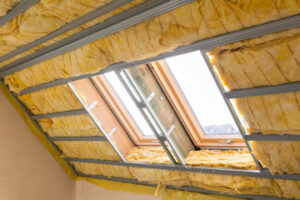Perth Insulation reduces energy consumption and lowers your home’s heating and cooling costs. It also provides other benefits like fire resistance and sound dampening.

There are several types of insulation – from cellulose loose-fill to fiberglass batts. Each one is impacted by water differently but all are crucial to keeping your home healthy and energy-efficient.
R-Value is the measurement of the ability of insulation to resist heat flow, and the higher the R-value, the more effective the insulation. However, R-Value is not the only factor that determines the thermal resistance of a building element like a wall or roof.
The thickness of the insulation also impacts its R-Value. For example, a certain type of foam insulation may have an R-Value that more than doubles when it’s thicker. This is because the k-value of this particular type of insulation increases with its thickness, making it more efficient at reducing energy loss.
It’s important to remember that R-values are calculated based on laboratory tests conducted under controlled conditions. Depending on the climate zone, different thicknesses and materials may be required to achieve a specified R-Value, which can make it difficult to compare insulation products based solely on their R-Values.
Another factor that influences R-Value is how the insulation is installed. For example, if fiberglass or cellulose insulation gets wet, the R-Value will decrease significantly as it retains moisture and loses its ability to insulate effectively. Fiberglass and cellulose are also known to shift, sag or settle over time, which can create gaps in the insulation where air can move through. This type of air movement can significantly reduce the effectiveness of traditional insulation, but there is an insulation option that eliminates this problem.
If you’re interested in evaluating the R-Value of your insulation, we recommend getting in touch with a professional who can conduct an inspection and consult your building plans or insulation specifications to determine whether your existing insulation meets recommended standards. An experienced insulation contractor can also help you evaluate hard-to-reach areas and check for gaps or settling that may impact your insulation’s effectiveness. They can also suggest alternative ways to improve your insulation to maximize its performance. Insulation that carries a high R-Value will help you save on your energy costs while creating a more comfortable indoor environment. However, the best insulation for your home will depend on other factors as well, including temperature, pressure and how the material is installed.
Condensation
When the air in a building is warmer than its surrounding ambient temperature it can cause condensation. This moisture can be a serious problem for a structure, especially when it is trapped inside insulation. Moisture penetration can lead to corrosion of metal components within a system and also create problems with the effectiveness of the insulation, as it will lose its R-Value.
The reason for this is simple – there is only so much water vapour that the air can absorb before saturation, which is known as the dew point. Once the air is saturated it will begin to release moisture on cold surfaces causing surface condensation, which can damage and stain walls and ceilings, and spoil goods and equipment. In addition to this, condensation trapped in insulation can contribute to higher energy bills as the heat of the trapped moisture is wasted.
Choosing the correct insulation for a project is essential to prevent these issues. Insulation with a high R-Value and a low Thermal Conductivity is the best solution, as it provides good protection against both surface condensation and interstitial condensation that can occur unseen inside the insulation.
The performance of an insulation material is based on many factors, including its thermal conductivity and its specific heat capacity. The latter is the amount of heat that a kg of the material requires to raise its temperature by 1K or one degree Celsius. Insulation with a higher Specific Heat Capacity is more effective, as it takes longer for the heat to transfer through the material.
A good insulator will have a low thermal conductivity, as well as a high Specific Heat Capacity and a high density. The density of an insulation material is determined by the pressure that is applied and the binder used to form the material. A low pressure and a high binder content will produce an insulation material with a very low thermal conductivity and a low specific heat capacity.
Many types of insulation are available, including fiberglass, mineral wool, polyurethane foam, cellulose, and phenolic foam. Each has its own unique properties and applications. It is important to understand these differences when selecting an insulation, as they will impact the overall cost and performance of the finished product.
Moisture
Moisture control is one of the more important aspects of insulation, as it directly impacts the efficiency and longevity of the product. Insulation is susceptible to moisture absorption, which affects thermal conductivity. Insulation with a higher thermal conductivity is more likely to become saturated and damaged by moisture.
This can be caused by condensation and air movement within the wall cavity. This is especially a problem with open-cell, blown cellulose, or mineral wool insulation. This is why these products are typically used with jackets to help prevent moisture infiltration. Another cause of moisture infiltration into insulation is through unintended paths for air movement such as cracks, gaps and holes. Moisture infiltration will decrease the effectiveness of insulation and increase heating and cooling costs.
As temperatures change, the humidity of the surrounding air will also change. The moisture concentration of the air, measured as relative humidity (RH), increases as it warms and decreases when it cools. The RH level at which water vapor in the air begins to condense is known as its dew point. As moist air enters a wall cavity, it will contact the first cold surface it encounters. This condensation can lead to wet insulation and framing.
When a wet insulation is installed, it will not perform effectively and will require replacement or repair. It can also create a breeding ground for mold and mildew, which poses health risks and can destroy building materials. Moisture control is vital to maintaining a healthy, energy-efficient home and can be accomplished through proper insulation, ventilation and air sealing.
In order to prevent moisture intrusion, it is essential that the insulating material be either vapor-open or vapor-tight. Vapor-open insulation is capable of moving moisture vapor through its thickness, while vapor-tight materials cannot. Vapor-open insulation should be well-fitted to the wall in order to reduce the possibility of air gaps where condensation could occur and allow for a better distribution of moisture throughout the cavity. Some vapor-open insulation materials are capillary active to some degree, meaning that liquid moisture may be redistributed by the action of gravity and evaporate when hygrothermal conditions allow for it.
Safety
Insulation is a critical part of any home or business structure. It helps regulate temperatures, maintain safety and cleanliness, and conserve energy. While insulation is essential, it must be installed properly to ensure maximum effectiveness. There are a few things that every installer should know about insulation to ensure it is done correctly and safely.
One of the most important aspects of insulation is its ability to resist liquid absorption. When liquids penetrate and contaminate insulation materials, it reduces their performance and creates fire hazards. To prevent this, the insulation must be water-resistant and have a low vapor transmission rate (VTR). This will ensure that liquids are not allowed to infiltrate the insulation, and that no water vapor can escape.
Another important factor is the temperature range that an insulation material can withstand. Different types of insulation have a different temperature limit, which is the lowest operating temperature at which they will still function effectively. This temperature limit is critical to choose when installing insulation because it will help to avoid premature failure and costly replacement costs.
Blown-in insulation is a type of insulation that is blown or sprayed into gaps, crevices, and spaces in walls, attics, and crawl spaces. This insulation is made up of loose fibers or small particles made from materials such as fiberglass, cellulose, and mineral wool. It can pose health risks because it contains tiny glass fibers that could irritate the skin, eyes, and lungs if touched or moved. It is recommended that workers wear personal protective equipment, or PPE, when working with these materials.
Another important aspect of insulation is its ability to reduce the spread of fire. Many insulation types, such as mineral wool and certain foams, have fire resistance properties that can slow or stop the passage of flames and heat through a building’s structure. This can help save lives by buying occupants time to evacuate and allow firefighters to better combat the fire. Additionally, insulation can also limit the amount of smoke produced during a fire, which can further aid evacuation and rescue efforts.
